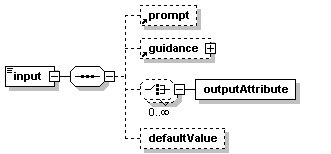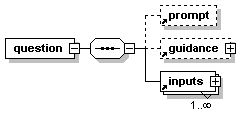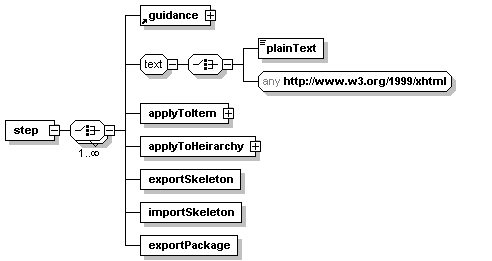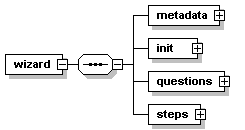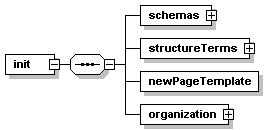| source |
<xs:element name="step">
<xs:annotation>
<xs:documentation>A single step in the wizard interface, representing one discrete part of the wizard.
A title attribute labels the step for user information.</xs:documentation>
</xs:annotation>
<xs:complexType>
<xs:choice maxOccurs="unbounded">
<xs:element ref="guidance"/>
<xs:group ref="text"/>
<xs:element name="applyToItem">
<xs:annotation>
<xs:documentation>applyToItem is a call to WCKER functionality, whereby:
1) a single part of the course structure is identified (via a "target" attribute), and
2) the questions defined in any nested "questionGroups" are presented to the user, for that part of the course.</xs:documentation>
</xs:annotation>
<xs:complexType>
<xs:sequence>
<xs:element ref="questionGroup" maxOccurs="unbounded"/>
</xs:sequence>
<xs:attribute name="target" type="xs:string" use="required"/>
</xs:complexType>
</xs:element>
<xs:element name="applyToHeirarchy">
<xs:annotation>
<xs:documentation>applyToHeirarchy is a call to WCKER functionality, whereby questions defined in any nested "questionGroups" are presented to the user, for every part of the course structure.
I.e. the questions are asked for the course root element, and every nested unit, page, etc.
WCKER also generated a tree view or the course structure.</xs:documentation>
</xs:annotation>
<xs:complexType>
<xs:sequence>
<xs:element ref="questionGroup" maxOccurs="unbounded"/>
</xs:sequence>
</xs:complexType>
</xs:element>
<xs:element name="exportSkeleton">
<xs:annotation>
<xs:documentation>exportSkeleton is a call to WCKER functionality, whereby a skeleton version of the course is generated from the course structure and (wizard provided) template files.</xs:documentation>
</xs:annotation>
</xs:element>
<xs:element name="importSkeleton">
<xs:annotation>
<xs:documentation>importSkeleton is a call to WCKER functionality, whereby the skeleton version of the course (generated by exportSkeleton) which has had the templates completed in, is imported by Reload.</xs:documentation>
</xs:annotation>
</xs:element>
<xs:element name="exportPackage">
<xs:annotation>
<xs:documentation>exportPackage is a call to WCKER functionality, whereby a content package is created from the imported skeleton.</xs:documentation>
</xs:annotation>
</xs:element>
</xs:choice>
<xs:attribute name="title" type="xs:string" use="required"/>
</xs:complexType>
</xs:element> |

